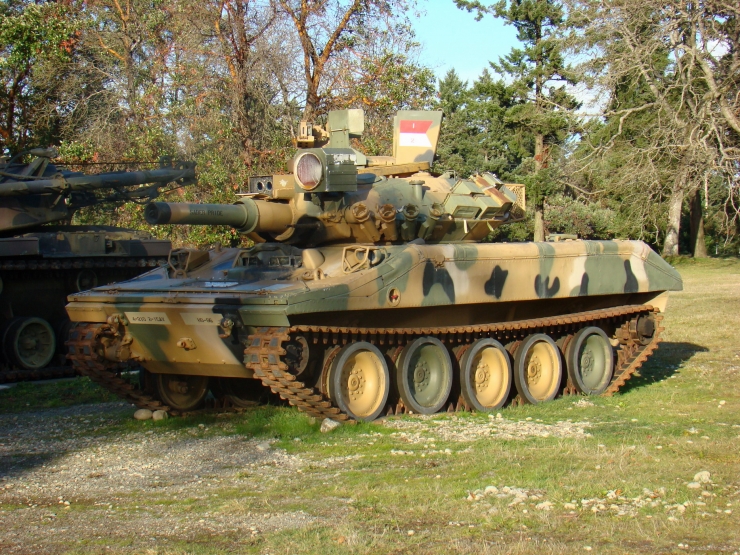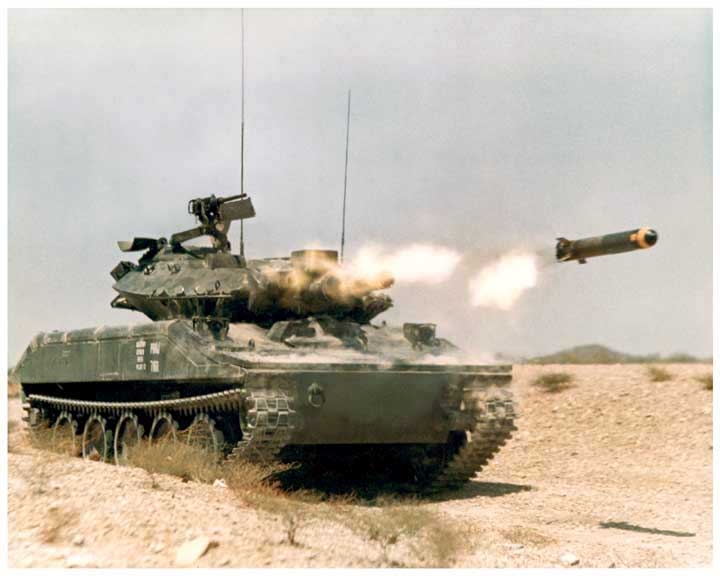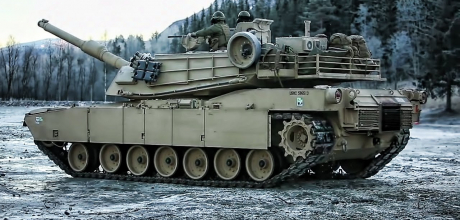Following three years of budget negotiations and roughly one year of preparations, limited production of the M551 was initiated in 1966 with the production variant more or less based on the twelfth prototype (the earlier prototypes served mostly to verify various technical solutions).
The M551 was officially accepted in service in May of 1966 and the first vehicle to arrive to an operational unit on 29.6.1966 was christened by General Frank S. Besson Jr., the commander of the Army Materiel Command as “M551 General Sheridan” (named after the famous Civil War general, Philip Henry Sheridan). The vehicle was mass-produced between 1962 and 1970 with 1662 made in total.

The tank was immediately submitted to series of tests in various climates and it was found out that even in humid environment, the Shillelagh missile was relatively functional. The same however could not be said about the semi-combustible casings of the 152mm shells – they got damp often, which resulted in many failures. Another issue was the fact that since the barrel was actually very short, it had no fumes extractor and the crew compartment often became filled with gunpowder residue and gasses regardless of the fact that the turret ventilation intake was located straight above the breech. To make things even worse, hot remnants of the semi-combustible casings remained in the barrel and there was always the danger of the loaded ammunition spontaneously combusting. To remedy this last issue, the Sheridans were equipped from February 1967 with the so-called Open Breech Scavenger System (OBSS), the purpose of which was to “flush” the inside of the barrel with compressed air, removing all the residue potentially left from the last firing. The compressed air was stored in two laminate pressure containers installed in front of the driver’s seat and they were pressurized to 3100 PSI by a compressor located under the seat itself. Three different versions of this system existed much to the “amusement” of the maintenance crews and generally it was not a very efficient solution anyway, it did not work well at all.

The worst testing results came from the trials that took place in 1967 in the humid environment of Panama. During one of the tests one loaded shell exploded while the gun breech was open. The explosion was the result of the abovementioned issue with hot residue staying inside the barrel and as a result, the crews and workers were now forbidden to store any ammunition in the tanks themselves and the production was temporarily stopped as well. This happened after the OBSS system was installed, leading to its replacement by the Closed Breech Scavenger System (CBSS) in 1968, which improved the safety of the whole firing mechanism significantly. The tests in Australia have shown roughly similar results and the general conclusion was that while the vehicle is not suitable for humid environments in dry and cold environments it works fine. These warnings however were disregarded and the first combat use of the Sheridan would indeed take place in Vietnam.
“Vietnamization”
The Sheridan deployment in Vietnam was a chapter unto itself. The vehicle was actually designed for the battlefields in Europe and to fight the Soviets and their mechanized infantry tactics – the Soviet APC’s (or IFV’s) carrying infantry were to be the primary targets, specifically before the infantry disembarks. That tactic however was not suitable for the asymmetric warfare in Vietnam and a new shell was required in order to deal with enemy footsoldiers. The result of that need was the XM625 “Beehive” flechette round. Filled with 9900 nail-sized needle shards, it could quite literally tear any infantry caught in the open to pieces. Another modification for the Vietnam battlefield would be the commander’s post on top of the turret, which received additional protection and the .50 caliber Browning M2 machinegun received a protective gun shield. As a result, the commander was somewhat protected from the front by that shield, from sides by the opened parts of the hatch and from behind by an additional ammunition and spare part box, which was ironically too small to hold the amount of spare parts and ammunition that was required. Some vehicles were modified even further by adding additional machineguns for the loader – or even a mortar or grenade launcher. The deployment to Vietnam uncovered further issues the vehicle had, some of which took years to remedy. The transmission for example was insufficient for the weight and power of the vehicle and the drivers had to be very careful with the clutch, otherwise there was a real danger of damaging the gears. This was especially a problem in two specific cases:
- Drivers, used previously to the handling of the M48 Patton tank were treating the clutch roughly, resulting in numerous breakdowns
- When the transmission was under unusual stress, for example when the Sheridans were leading the way through the jungle, making a way for the following M113 APC’s
The fragility and improper construction of the RPM limiter led to various failures as well, stalling the engine or allowing the RPM to run too high and damaging it. The turret was also a nightmare and to this day it is currently considered to be one of the worst weapon systems ever to see service in the US Army.

The “joys” of firing the Sheridan gun
Describing the “pleasure” of fighting in the real Sheridan hardly does it justice, so let’s have a look at just a few examples of the issues the turret crew had to face. In regular tanks, overpressure in the recoil hydraulics usually resulted in busted seals, which were not hard to replace. In the Sheridan however, such overpressure was theoretically prevented by a valve-screw that however failed quite often, resulting in the turret crew being showered by the red hydraulic fluid (nicknamed “cherry juice”).
Another source of constant irritation was the wiring of the turret. The main circuits were distributed to ten removable separate circuit boards. The problem was that the violent recoil of the gun often “shook” them out of their beds, resulting in various electric failures and short circuits. Given the fact that the gun was fired by an electric mechanism, such a failure was possibly disastrous for the vehicle. Especially susceptible to various breakdowns and short circuits were the transformers. The carbon residue from the semi-combustible casings got stuck to the electrical wiring in the gun firing mechanism, significantly reducing its reliability. These issues were far from rare, they sometimes appeared even after two or three shots and on average the Sheridan crews reported one gun failure per 50 shots.
The proverbial cherry on the top was the firing of the full-charge HE and HEAT ammunition from the gun. The “Beehive” rounds were relatively fine because they used reduced charges but when firing the full charge HE and HEAT rounds, the vehicle shook violently and its front roadwheels were actually thrown up in the air by the recoil while the tank was temporarily covered by a thick cloud of smoke. This negatively influenced the Shillelagh missile targeting system and after firing a few regular rounds, it was problematic to actually launch the missile and hit anything.

The loader had possibly the worst job of the entire crew. Operating the breech itself was not exactly easy as the electric part of the breech failed for the reasons mentioned above often and it had to be opened manually using a crank. Operating this crank was difficult in the cramped turret and the loaders hated it with passion. It was also very important for the loader not to forget to switch to “gun” mode when firing a regular round if the last round he fired was a missile. If he forgot to do that, the missile launch mechanism would rip the side of the shell combustible case open and the gunpowder granules would spill on the turret floor. The missile rounds were large and difficult to manipulate as well and there were issues with unfired rounds getting sometimes stuck in the barrel.
Finally, a rather nasty flaw was that when the gun was elevated to its maximum position, for some reason the turret started randomly rotating left due to an undisclosed flaw – the gunners were not amused. Most of these problems were eventually corrected throughout the service, which will be described in the third and final Sheridan article series.








